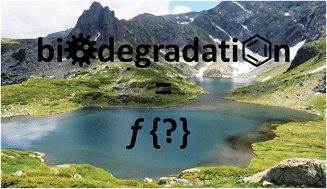当前位置:
X-MOL 学术
›
Environ. Sci.: Processes Impacts
›
论文详情
Our official English website, www.x-mol.net, welcomes your
feedback! (Note: you will need to create a separate account there.)
Quantitative structure–activity relationships for primary aerobic biodegradation of organic chemicals in pristine surface waters: starting points for predicting biodegradation under acclimatization†
Environmental Science: Processes & Impacts ( IF 4.3 ) Pub Date : 2017-11-14 00:00:00 , DOI: 10.1039/c7em00375g Tom M. Nolte 1, 2, 3, 4, 5 , Kevin Pinto-Gil 6, 7, 8, 9, 10 , A. Jan Hendriks 1, 2, 3, 4, 5 , Ad M. J. Ragas 1, 2, 3, 4, 5 , Manuel Pastor 6, 7, 8, 9, 10
Environmental Science: Processes & Impacts ( IF 4.3 ) Pub Date : 2017-11-14 00:00:00 , DOI: 10.1039/c7em00375g Tom M. Nolte 1, 2, 3, 4, 5 , Kevin Pinto-Gil 6, 7, 8, 9, 10 , A. Jan Hendriks 1, 2, 3, 4, 5 , Ad M. J. Ragas 1, 2, 3, 4, 5 , Manuel Pastor 6, 7, 8, 9, 10
Affiliation

|
Microbial biomass and acclimation can affect the removal of organic chemicals in natural surface waters. In order to account for these effects and develop more robust models for biodegradation, we have compiled and curated removal data for un-acclimated (pristine) surface waters on which we developed quantitative structure–activity relationships (QSARs). Global analysis of the very heterogeneous dataset including neutral, anionic, cationic and zwitterionic chemicals (N = 233) using a random forest algorithm showed that useful predictions were possible (Qext2 = 0.4–0.5) though relatively large standard errors were associated (SDEP ∼0.7). Classification of the chemicals based on speciation state and metabolic pathway showed that biodegradation is influenced by the two, and that the dependence of biodegradation on chemical characteristics is non-linear. Class-specific QSAR analysis indicated that shape and charge distribution determine the biodegradation of neutral chemicals (R2 ∼ 0.6), e.g. through membrane permeation or binding to P450 enzymes, whereas the average biodegradation of charged chemicals is 1 to 2 orders of magnitude lower, for which degradation depends more directly on cellular uptake (R2 ∼ 0.6). Further analysis showed that specific chemical classes such as peptides and organic halogens are relatively less biodegradable in pristine surface waters, resulting in the need for the microbial consortia to acclimate. Additional literature data was used to verify an acclimation model (based on Monod-type kinetics) capable of extrapolating QSAR predictions to acclimating conditions such as in water treatment, downstream lakes and large rivers under μg L−1 to mg L−1 concentrations. The framework developed, despite being based on multiple assumptions, is promising and needs further validation using experimentation with more standardised and homogenised conditions as well as adequate characterization of the inoculum used.
中文翻译:

原始地表水中有机化学物质的主要需氧生物降解的定量构效关系:在适应环境下预测生物降解的起点†
微生物的生物量和适应能力会影响天然地表水中有机化学物质的去除。为了解决这些影响并开发更健壮的生物降解模型,我们收集并整理了未驯化(原始)地表水的去除数据,并在此数据上建立了定量构效关系(QSAR)。使用随机森林算法对包括中性,阴离子,阳离子和两性离子化学品(N = 233)在内的非常异构的数据集进行全局分析,结果表明有用的预测是可能的(Q ext 2= 0.4-0.5),尽管相关的标准误差较大(SDEP约为0.7)。根据物种形态和代谢途径对化学物质进行分类表明,生物降解受这两种影响,并且生物降解对化学特性的依赖性是非线性的。类特定的QSAR分析表明,形状和电荷分布确定的中性化学品的生物降解(- [R 2〜0.6),例如,或通过膜渗透结合P450酶,而电荷的化学品的平均生物降解是大小为1至2个数量级下,其降解更直接取决于细胞摄取(R 2〜0.6)。进一步的分析表明,特定的化学类别(如肽和有机卤素)在原始地表水中的生物降解能力相对较低,因此需要微生物群落适应。使用其他文献数据来验证能够将QSAR预测外推到适应条件的适应模型(基于Monod型动力学),例如水处理,下游湖泊和大河中浓度为μgL -1到mg L -1的条件。尽管基于多种假设而开发的框架是有希望的,并且需要使用更加标准化和均质化的条件以及所用接种物的充分表征进行实验,以进行进一步的验证。
更新日期:2017-11-14
中文翻译:

原始地表水中有机化学物质的主要需氧生物降解的定量构效关系:在适应环境下预测生物降解的起点†
微生物的生物量和适应能力会影响天然地表水中有机化学物质的去除。为了解决这些影响并开发更健壮的生物降解模型,我们收集并整理了未驯化(原始)地表水的去除数据,并在此数据上建立了定量构效关系(QSAR)。使用随机森林算法对包括中性,阴离子,阳离子和两性离子化学品(N = 233)在内的非常异构的数据集进行全局分析,结果表明有用的预测是可能的(Q ext 2= 0.4-0.5),尽管相关的标准误差较大(SDEP约为0.7)。根据物种形态和代谢途径对化学物质进行分类表明,生物降解受这两种影响,并且生物降解对化学特性的依赖性是非线性的。类特定的QSAR分析表明,形状和电荷分布确定的中性化学品的生物降解(- [R 2〜0.6),例如,或通过膜渗透结合P450酶,而电荷的化学品的平均生物降解是大小为1至2个数量级下,其降解更直接取决于细胞摄取(R 2〜0.6)。进一步的分析表明,特定的化学类别(如肽和有机卤素)在原始地表水中的生物降解能力相对较低,因此需要微生物群落适应。使用其他文献数据来验证能够将QSAR预测外推到适应条件的适应模型(基于Monod型动力学),例如水处理,下游湖泊和大河中浓度为μgL -1到mg L -1的条件。尽管基于多种假设而开发的框架是有希望的,并且需要使用更加标准化和均质化的条件以及所用接种物的充分表征进行实验,以进行进一步的验证。











































 京公网安备 11010802027423号
京公网安备 11010802027423号